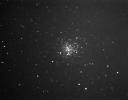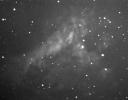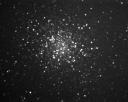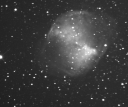I wasn’t expecting a gap in the clouds but I made the most of the opportunity when it came. I only wish I’d been able to stay awake longer to take advantage of this rare occurrence.
As I noticed the clouds breaking up I decided to do some mount tuning before starting an imaging session. I’ve had a couple of attempts since the last post, but haven’t been happy with the amount of movement in the images.
I started by realigning my polar scope. I did this during daylight by sighting on my neighbours weather vane and rotating the mount to make sure the cross hairs stay centered. Some adjustment was required but it only took a few minutes to rectify the issue.
Next I found I could detect movement in the mount head by rocking it with my hand. I made some adjustments to the hex bolts and was able to remove all movement, but knew this could have an affect on the gear mesh so my next step was to power it up and slew the scope around. Sure enough the mesh was too tight and I had to make some minor adjustments to make sure the gears moved without jamming and there was no movement when I rocked the mount head.
What else could be affecting my imaging? Well I’ve always been a little concerned about the third weight I use to balance the scope. I described in an earlier post how I picked up a 5KG weight-lifting weight from a local supermarket to help balance the scope and sandwiched this between the 2 weights that came with the mount. The central hole in the weight is too big for the shaft but until now I hadn’t taken any notice of this. To remedy this issue I took a roll of masking tape and wound it around the shaft until the weight fitted snuggly over – problem solved.
So now I only had to wait for darkness to see if I’d made things worse or better.
Turning on “Messier labels” in Starry night showed me a number of the southern M’s were within reach being higher in the sky during the summer months. Some of these I’ve never imaged before so I set about what turned into a miny Messier marathon. Initially I was limited to 10 second images as the sky was not yet fully dark and longer exposures where not possible. I started with the lowest M I could get at given the obstacles that hinder my South and South West view. So the session went something like M28,M22, M8, M21, M23, M9, M18, M17 and M16.
M8 was disappointing, I found I was still getting movement in the images so longer exposures were not possible. For this reason I skipped M20 the Triffid stayed mostly with Clusters.
I finished the evening by looking at PemPro and PERecorder to see if I could create a PEC curve to help with the mount movement, but time ran out and at 1:20am I called it a day. Next time I get a clear night I’ll start recording PE earlier to make sure I have enough time to do this properly. What I did find was it looks like the mount has +20 to -20 Arcsecond movement which seems to be about normal for an EQ6. I think need at least half this for decent images.
So here are the new images, I’ll have to remember to update the Messier Catalogue on the images page.

M9 – Globular Cluster |

M16 – The Eagle Nebula |

M17 – The Swan Nebula |

M18 – The Black Swan |

M21 – Open Cluster |

M22 – Saggittarius Cluster |

M23 – Open Cluster |

M28 – Globular Cluster |
|
























